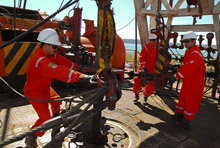
Typical street scene in Santa Ana, El Salvador. (Photo: iStock)
IMF Survey: Tailwinds Pose Risks For Latin America
March 28, 2011
- Commodity boom helping fuel Latin-American growth
- Some dynamic economies should slow expansion to avoid problems
- Capital controls can be part of overall toolkit of measures
High global commodity prices and easy financial conditions are fuelling rapid growth in many Latin American countries but they should be careful of being swept along by tailwinds that could result in them growing too fast, triggering inflation that can harm the most vulnerable, said Nicolas Eyzaguirre, head of the IMF’s Western Hemisphere Department.

Workers extracting oil in Southern Argentina. Strong demand for commodities has boosted growth in Latin America (photo: Leonardo Petricio/dpa)
INTERAMERICAN DEVELOPMENT BANK MEETING
Speaking at a press conference in Calgary, Canada, during the annual meetings of the Inter-American Development Bank (IDB), Eyzaguirre said that commodity exporters in Latin America are benefitting from strong demand in Asia, particularly China, for its food and natural resources.
This had helped boost growth, even though the hemisphere’s dominant economy, the United States, was still struggling to recover from the crisis.
During the global recession, as in many other parts of the world, Latin American countries had adopted simulative policies to help them ride out the economic crisis. But because of good economic policies put in place before the crisis, many of them had weathered the storm well and had recovered fast.
Neutral gear
Now, with growth stimulated by external factors such as capital inflows and high commodity prices, they should put their monetary and fiscal policies back into neutral gear and look at restoring interest rates to more normal levels.
“The trade cycle of Latin America is now more closely tied to Asia, and particularly China,” Eyzaguirre told reporters on March 27 in snow-bound Calgary.
Earlier, IMF Managing Director Dominique Strauss-Kahn warned in the IMF’s Spanish blog Diálogo a Fondo that there were worrisome signs of overheating in some Latin American economies.
Eyzaguirre, a former finance minister of Chile, said that some South American countries were growing at above potential, meaning they were starting to see inflationary pressures because of high demand and strong inflows of capital, although some others in Central America and the Caribbean were less vibrant.
Governments should act in a measured way to keep these pressures in check to avoid a later sudden deceleration that could translate into job losses that again would hit the most vulnerable the hardest. “It’s very important for social cohesion,” he added.
But IMF economists stressed that there was no single prescription for Latin American economies. Countries with more dynamic economies should consider raising interest rates to avoid overheating.
Eyzaguirre said that countries could consider capital controls as part of the toolkit of measures, but conventional monetary and fiscal policies should be the first options, along with macroprudential measures. “What we are saying is that we should be pragmatic,” he said.
“When tailwinds are very strong you should consider in your policy toolkit as many policies as you can because when these push factors are strong enough you may not afford constraining yourself to the most traditional ones.”







